Abstract
The enhancement of manganese steel castings through the incorporation of magnesium, calcium, and surface-active elements has been investigated with a focus on improving ceramic-metal composite structures. This study demonstrates that treating the casting surface with magnesium significantly enhances the bond between alumina ceramic and manganese metal, attributed to a high fraction of interphase formation. Furthermore, the composite structure formed between modified molten manganese metal and alumina exhibits superior wear abrasion resistance compared to conventional manganese steel. The wear abrasion resistance was improved seven times in comparing to the conventional high manganese steel. Additionally, the well-known strain hardening phenomenon of high manganese steel is substantially influenced by the composite structure at the surface, suggesting a novel approach to tailoring mechanical performance in demanding applications. These findings highlight the potential of surface modification techniques to optimize the durability and mechanical integrity of manganese steel castings in wear-intensive environments.
Keywords: composite structure, ceramic-metal composite, high manganese steel, wear abrasion resistance, reinforcement of casting surface
Introduction
High manganese steel, renowned for Hadfield steel, is widely applied for various industry applications such as cement production, mining, road construction, and railways.1 Significant research has been conducted to clear the effect of alloying elements on mechanical properties of Hadfield steel.2,3 This improves the hardness and strength of the primary austenite structure, thereby enhancing its resistance to wear and abrasion.4 Moghadam et al.5 studied the impact of vanadium on wear abrasion of Hadfield steel; they concluded that the optimal mechanical properties such as highest hardness, highest impact toughness, and highest abrasion resistance attributed by adding 1% mass of V as an alloying element to high manganese steel. The addition of titanium to this steel has been highly effective in producing a fine-grained structure and enhancing its hardness and wear abrasion.6,7 Although the significant effect of alloying elements on improving wear abrasion of high manganese steel is still suffering from wear abrasion resistance, so metal-ceramic composite structure (MCCS) is a novel technique to replace the conventional metal matrix against wear abrasion applications. Numerous studies have explored this innovative technique for reinforcing the metal matrix of chromium cast iron. However, its application to Hadfield steel is not yet well-defined,8,9 so that this direction is a promising route owing to its great importance in materials with wear resistance industrial applications. Preparation of Hadfield steel reinforced with ceramic is highly challenging requiring consideration of numerous factors. The thermophysical properties and the interface structure between the reinforcing particles and the matrix are essential factors in enhancing the performance of composites.10 On the other hand, the role of titanium as an active element was further addressed in several occasions. In addition, several research has discussed the role of magnesium and/or calcium in reducing the surface tension and improving the wettability through reduction the sulfur content of the molten steel. Thereby, it is expected that the presence of active element like titanium, and/or modification of molten high manganese steel by Mg, or Ca will affect the reinforcement of manganese steel casting surface with ceramic-metal composite structure.11,12,13,14 This work aims to study the Hadfield steel casting surface and enhance its wear abrasion through MCCS technology. Ti was used as active element for improving the interface bonding between the steel matrix and alumina ceramic particles, reducing the likelihood of particle pull-out during wear. Mg and Ca were added to the molten metal for enhancing the wettability, consequently reducing the grain size in the molten metal during solidification by promoting heterogeneous nucleation to obtain fine-grained microstructures improve wear resistance of Hadfield steel.
Methodology
Disposable foam patterns were prepared from expanded foam blocks as 300 × 100 × 50 mm with density 30 kg/m3, and 1:2 hole diameter to wall thickness using CNC milling as shown in Figure 1. The angular alumina ceramic particles with size 1:3 mm were packed in the insert (foam pattern) with depth 40 mm, as given in Fig. 2. Their chemical composition are detailed in Table 1. Three heats of Hadfield steel were melted in an open-air manganese spinel crucible induction furnace with a capacity of 30 kg. Their chemical compositions were adjusted as given in Table 2. Titanium with 1mm size in the form of ferrotitanium (35% Ti, 2%Al, 4%Si, Bal.% Fe) was added to all the heats acting as a key component for enhancing the interfacial bonding between the steel matrix and alumina ceramic particles. Heat No. 2 was ladle treated with specific amount of ferrosilicon magnesium while heat No. 3 with Ca-Si as specified in Table 1. The molten metal fully deoxidized by aluminum inside the crucible of the induction furnace. Each heat was poured at 1540 °C into a sodium silicate sand mold of a standard sample cavity. Sure, sodium silicate sand mold was cored with CO2 gas to attain the proper mold strength as shown in Fig. 3. Samples have been cut as shown in Fig. 4 and subjected for microstructure observation by optical and scanning electron microscope. SEM detected the structure at the interface and the compound that could be formed through the solidification of molten metal. Samples were subjected to X-ray diffractometer with Cu-source to detect the phases that are formed on the reinforced surface; also, it was used to detect the worn surface structure after wear abrasion conditions. Wear abrasion resistance was determined by using abrasive sand particles with size 400-750 microns by using abrasive wear test apparatus according to ASTM G65 as shown in Fig. 515 to detect the behavior of reinforced manganese steel either on low or high gouging applications.

Figure 1. Foam pattern.

Figure 2. Ceramic insert.
Table 1. Chemical Compositions of Al2O3

Table 2. Chemical Compositions and Production Processes of the Investigated Steels


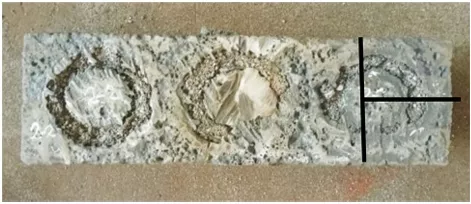
Results and Discussions
Microstructure observations
-
Optical microstructure observations
As being mentioned before, the work has been designed to study the effect of the surface-active element as titanium and the modified molten steel element as Ca and Mg on the reinforcement of manganese steel casting surface with ceramic-metal composite structure. In fact, the microstructure observations have been applied on the samples after ordinary heat treatment process, which includes heating for 1050 °C and rapid quenching in water. The ceramic on reference surface which has not contained surface-active metal in ceramic or modifying element in molten metal has been completely collapsed. Certainly, this confirms the necessity of the presence molten metal modifying elements. The microstructure of the reference steel is clearly observed in Fig. 6a that contains of lower size of austenite grains at the interface between ceramic and metal, referring to the affinity of titanium in dissolving in the molten high manganese steel. On the other hand, magnesium, as a modifying element for molten metal, acts with titanium as an active element in increasing the strength on binding between the ceramic alumina particles with high manganese steel.16 It is observed, strong interface along the structure between the metal and the ceramic particles as shown in Fig. 7. In addition, it is observed a grain refinement happened to the austenite structure which confirms the high solubility of titanium in the molten high manganese steel regarding to its high affinity for carbon. Furthermore, the strong bond between the metal and the ceramic particles in magnesium-treated high manganese steel refers to the effect of magnesium in modifying the molten steel physical properties.17 Regarding to the affinity of magnesium for sulfur and oxygen as given in Eq. 1, 2, it has a great effect on reducing the surface tension of molten steel due to reducing the surface-active element like sulfur and oxygen.18 Magnesium is a known modifier of inclusions, promoting the formation of spherical inclusions with alumina base ceramic (like MgO–Al2O3) which acts as nuclei for cementite nucleation as being observed in Fig. 6b. These inclusions affect the overall cleanliness and fluid properties of the molten steel. The high vapor pressure and rapid volatilization of magnesium at the steel making temperature lead to dynamic changes in the steel's surface characteristics.
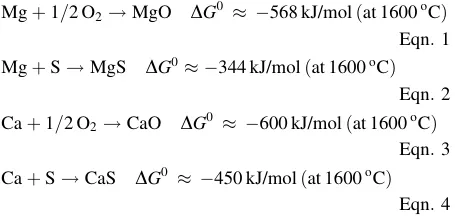
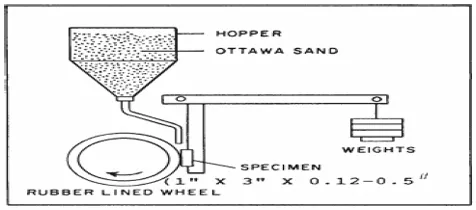
Figure 5. Schematic diagram of wear abrasion test apparatus.
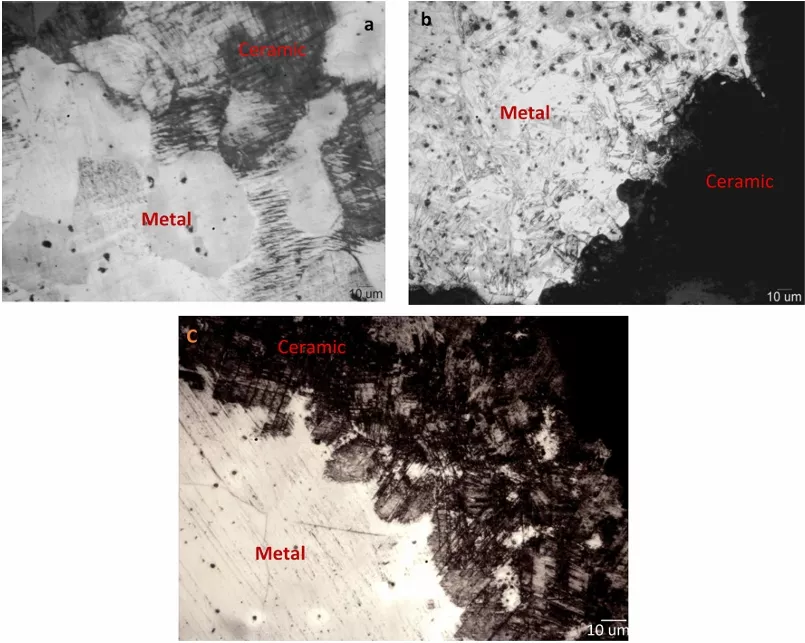
Figure 6. Microstructure of reinforced high manganese steel surface with MCC structure. (a) reference steel, (b) magnesium-treated high. manganese steel, c calcium-treated high manganese steel (400x mag).
In calcium-treated high manganese steel, the depth of ceramic-metal composite structure in much lower than that was observed at magnesium-treated high manganese steel at the constant of surface-active element adding to ceramic. In addition, low effect on grain size of austenite has been observed as shown in Fig. 6c which refers to weak interaction observed between the metal and the ceramic particles. Also, this can explain the low effect of calcium on removing the sulfur and oxygen from the molten steel in comparing to magnesium, as being confirmed in Eq. 3, 4.
-
SEM observations
It is clear that the strong interphase between ceramic particles and high manganese steel metal was established regarding to the effect of magnesium in reducing the sulfur and oxygen content, providing a molten steel with low surface tension that can wet on unwettable alumina base ceramic particles. At the meantime, form EDX of austenite matrix it was clear that titanium has a great affinity in dissolving in molten high manganese steel owing to its high carbon content as shown in Table 3. Moreover, the interphase between austenite matrix and ceramic particles explains the role of titanium and magnesium in enhancing the metal-ceramic composite structure. EDX analysis indicates that the magnesia has reacted with alumina base ceramic particles to provide complex structure which promotes the binding strength between the ceramic and metal. In addition, the spheroidal structure that has been observed among the austenite matrix refers to the eutectoid compounds that is forming at the magnesia nuclei, which has been proved in several occasions.19 In calcium-treated high manganese steel, short and weak interface has been observed regarding to the weak effect of calcium in removing the surface-active element from the molten metal, as being explained before in equations. But, it is still observed enhancement in comparing with the reference high manganese steel without treatment as shown in Fig. 8.

Figure 7. Microstructure of magnesium-treated high manganese steel showing strong interface along the structure between the metal and the ceramic particles (400x mag).

Figure 8. SEM micrograph of (a) magnesium-treated high manganese steel; (b) calcium-treated high manganese steel.
Table 3. The Results of EDX Analysis of Arrow Points of Fig. 8, Weight %

-
Microhardness detection
Microhardness test is crucial to observe the change of hardness among the main austenite matrix and interphase matrix. It can be used to understand the diffusion of ceramic surface-active element (Ti) in the molten high manganese steel. It can be also used for explaining the compounds that can be formed between the ceramic and the modifying surface of molten manganese steel as Mg and Ca. Figure 9 and Table 4 present that the enhancement in the austenite matrix is highly observed in the case of magnesium-treated high manganese steel which should be attributed to the effect of grain refinement of austenite matrix by titanium as being discussed before in SEM observation. No doubt, the diffusion of titanium in the austenite matrix has a great effect in multiplying the main hardness of austenite matrix which is normally between (180–220 Hv).20 In addition, the hardness of interface has a great value to be compared with austenite or any other martensite structure. The high value of interface reflects a strong bonding mechanism has been established between the alumina base ceramic particles and the magnesium-treated molten steel. It was referred in SEM to the possibility of forming spinel compounds between magnesium and alumina that support the strong bond between the ceramic particles and high manganese steel. On contrary, lower hardness value was observed at the interphase between the ceramic and high manganese steel modified by calcium treatment. Many work have published the ability of calcium oxide to react with alumina at molten steel temperature to form compounds with low mechanical properties. Certainly, the surface of reinforced high manganese steel either treated by magnesium or calcium will be monitored by XRD to find out the most expected compounds that can be formed through the reinforcement of modified high manganese steel with ceramic particles, as being discussed later.
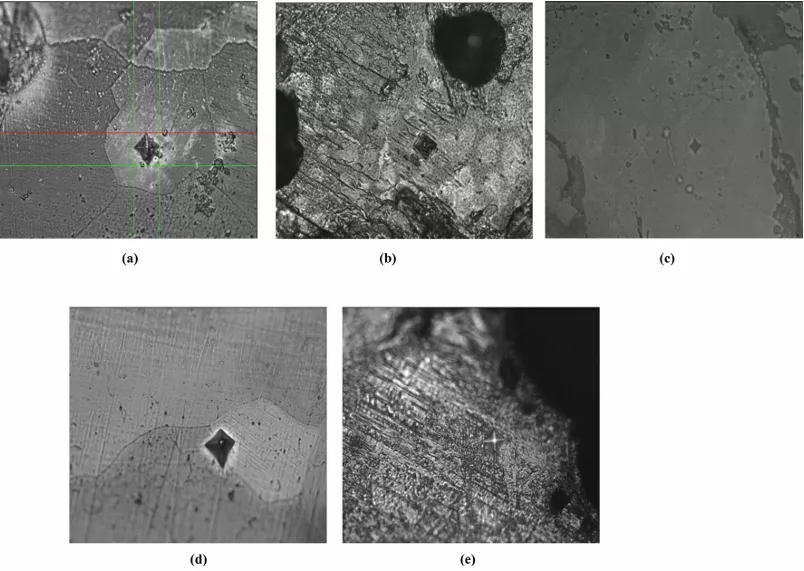
Figure 9. Microhardness indentation of (a) austenite matrix of ceramic surface-active element (Ti) in the molten high manganese steel; (b) austenite matrix of high manganese steel treated with Ti and Mg; (c) interface in case of Mg; (d) austenite matrix in case of Ca; (e) interface in case of Ca.
Table 4. Microhardness Results, Hv

-
XRD
X-ray diffraction has been carried out to identify the phases that are formed during the interaction between the molten metal and ceramic insert. It is supposed that the titanium containing ceramic insert interacts with the molten metal, forming a new composite structure that can reinforce the manganese casting surface, and consequently improve the wear abrasion resistance of the casting surface. In fact, it is assumed that either the modification of molten manganese steel by magnesium, and calcium or the improvement of the contact angle of alumina may act as a key player in reinforcement of manganese casting surface. Based on the data acquired from X-ray diffraction patterns as given in Fig. 10, modification of manganese steel molten metal by magnesium has a great effect on encouraging the interphase structure between the molten manganese steel and alumina. It was observed that high fraction (18.2%) of interphase structure between alumina and manganese steel in regarding to that observed in nonmodified manganese steel. At the meantime, calcium-modified molten manganese steel shows also interphase structure with lower fraction (8.5%) than that was observed in magnesium-treated molten manganese steel. Certainly, the affinity of either magnesium- or calcium-treated molten manganese steel for forming interphase structure can be explained by the reactions Eqns. 5–9.

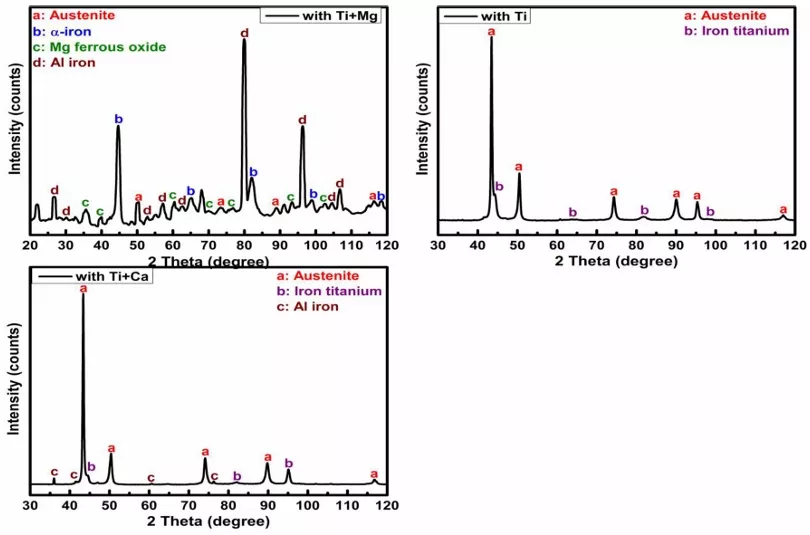
Figure 10. XRD patterns of (with Ti1Mg) high manganese steel treated with Mg; (with Ti) nonmodified high manganese steel; (with Ti1Ca) high manganese steel treated with Ca.
-
XRD-worn surface
The strain hardening phenomenon of austenitic high manganese steel can explain the using of high manganese steel in wear abrasion applications. This phenomenon can be established by transferring of gamma FCC austenite matrix into BCC martensite matrix through the accumulated strain energy that is acquired through the wear abrasion applications. Thereby, the fraction of alpha structure refers to the rate and the value of strain hardening ability of high manganese steel casting surface. XRD patterns of the worn surface refer to the great affinity of magnesium-treated reinforced surface for strain hardening and providing high fraction of alpha-martensite (62.1%) in comparing with the reference high manganese steel (31.9%) or nonmodified molten high manganese steel (24.7%), as given in Fig. 11.

Figure 11. XRD patterns of the worn surface (Ref) reference high manganese steel (with Ti) high manganese steel with Ti as surface-active element; (with Ti1Ca) high manganese steel treated with Mg; (with Ti1Mg) high manganese steel treated with Ca.
-
Wear abrasion resistance
ASTM-G65 wear abrasion test technique has been used for studying the wear abrasion resistance of conventional high manganese steel, and reinforced high manganese steel. It is observed that the reinforced surface of high manganese steel modified with magnesium introduces an excellent wear resistance against the wear abrasion conditions.21 The wear abrasion resistance of magnesium-modified reinforced high manganese steel is around seven times of that observed for conventional high manganese steel, as observed in Table 5. No doubt, the reinforced surface through the composite structure that has been formed between the molten metal and the ceramic particle as interphase structure acts as the powerful player in multiplying the wear abrasion resistance has been discussed in XRD and SEM observations. Based on the wear abrasion resistance results, it is clear that reinforcement of modified high manganese steel with ceramic-metal composite structure can multiply the life time of high manganese steel either at low or high gouging applications.
Table 5 Wear rate values of investigated steel

-
SEM-worn surface
Microplowing and microcutting are widely observed in the worn surface of conventional high manganese steel.22 This refers to the tremendous effect of abrasive particles on the worn surface. On contrary, no wear mechanism has been observed in the worn surface of the magnesium-modified ceramic reinforced high manganese steel as given in Fig. 12. Instead, it is observed discontinuous scratch mechanism with microcutting mechanism at the poor reinforced area. On the other hand, reinforced calcium-treated high manganese steel surface shows great fractions of microplowing and a few fractions of microcutting as shown in Fig. 13. Then, it can be concluded that the reinforcement of modified high manganese steel by magnesium could introduce a significant competitive to the conventional high manganese steel. In addition, calcium-treated reinforced high manganese steel can be also provide a powerful substitution to the conventional Hadfield steel against high-wear abrasion applications.

Figure 12.. SEM and EDX of worn surface of high manganese steel treated with Mg.
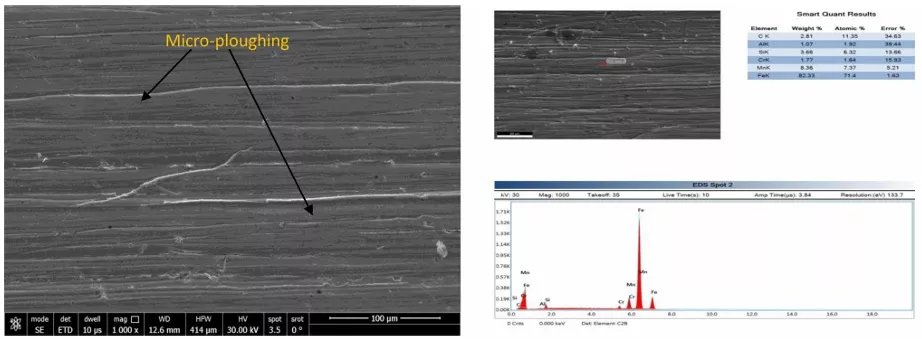

Figure 13.. SEM and EDX of worn surface of high manganese steel treated with Ca.
Conclusions
- 1.
Magnesium facilitates the formation of spherical inclusions with an alumina-based ceramic composition (such as MgO–Al2O3), serving as nucleation sites for cementite, while, in calcium-treated high manganese steel, the depth of the ceramic-metal composite structure is significantly lower than that observed in magnesium-treated high manganese steel when the amount of surface-active element added to the ceramic remains constant. Additionally, the effect on austenite grain size is minimal.
- 2.
The EDX analysis of the austenite matrix revealed that titanium exhibits a strong tendency to dissolve in molten high manganese steel due to its high carbon content. Furthermore, the interface between the austenite matrix and ceramic particles highlights the contribution of titanium and magnesium in strengthening the metal-ceramic composite structure.
- 3.
The improvement in the austenite matrix is most noticeable in magnesium-treated high manganese steel, which can be attributed to the grain refinement effect of titanium on the austenite matrix, hence multiplying the hardness of austenite matrix. In addition, the hardness of interface has a great value to be compared with austenite or any other martensite structure.
- 4.
High fraction (18.2%) of interphase structure between alumina and manganese steel in regarding to that observed in nonmodified manganese steel. Additionally, calcium-modified molten manganese steel shows also interphase structure with lower fraction (8.5%) than that was observed in magnesium-treated molten manganese steel.
- 5.
The XRD patterns of the worn surface indicate a strong tendency for strain hardening in the magnesium-treated reinforced surface, resulting in a high alpha-martensite fraction (62.1%). This is significantly greater compared to the reference high manganese steel (31.9%) and the nonmodified molten high manganese steel (24.7%).
- 6.
The magnesium-modified reinforced high manganese steel exhibits approximately seven times higher wear resistance than conventional Hadfield steel, highlighting its potential for high-wear industrial applications such as mining and construction.
References: Omitted
Declaration: This article is provided by CERADIR™ users or obtained from Internet, the content does not represent the position of CERADIR™. We are not responsible for the authenticity/accuracy of the article, especially the effects of the products concerned. This article is for study only, it does not constitute any investment or application advice. For reprinting, please contact the original author. If it involves the copyright and/or other issues, please contact us and we will deal with it asap! CERADIR™ has the interpretation of this declaration.







